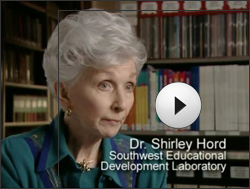Innovation Configurations
When launching a new program, education leaders often provide teachers with a few days of training on the process and then send them back to the classroom. Once there, teachers may discover they have no clear idea of what the program should actually look like in practice. Innovation Configurations (ICs) solve this problem by providing a well-defined picture of what constitutes stellar—and not so stellar—implementation of a program. With this model to guide them, staff are far more likely to achieve the desired results.
In a Nutshell
The Innovation Configuration construct is one of three diagnostic dimensions of the Concerns-Based Adoption Model (CBAM). Leaders use this component with staff to develop a unique set of expected actions and behaviors for each person or role involved in a program.
The Innovation Configuration process
- provides clear, specific, and shared descriptions of what a new program or practice should look like;
- focuses on the key components of a program or practice;
- describes variations for each component of a new program in terms of the actions and behaviors that are ideal, acceptable, and unacceptable;
- differs from rubrics in that Innovation Configurations describe rather than rate a new practice;
- produces flexible documents that can change as the use of a new program or practice matures; and
- helps teachers who are new to a school understand program expectations.
Innovation Configuration Maps
The primary product of the Innovation Configuration analysis process is an Innovation Configuration Map. An IC Map describes different ways that someone might implement an innovation. It includes components of the innovation and their variations. For example, an IC Map for a new science program might include materials used, teacher behaviors, and student activities—describing the ideal, acceptable, and less desirable variations of implementation.
The Science Program Innovation Configuration Map
| Component 1: The teacher groups students for learning. | |||
| (a) Assigns students to groups that vary over time based on instructional objectives and students’ ability. | (b) Assigns students to small permanent groups for lab assignments and other group work. | (c) Assigns students to groups during lab activities only. | (d) Provides whole group instruction exclusively. |
| Component 2: The teacher emphasizes science process and program content. | ||||
| (a) Emphasizes science process and program content equally. | (b) Emphasizes the science program content exclusively. | (c) Emphasizes the science process exclusively. | (d) Emphasizes science recall and memorization of facts from a variety of sources. | (e) Emphasizes recall of science facts from previous science textbook. |
Use and Application
What does the IC mapping process involve?
At the start of a new program, or at some point along the way, school or district leaders work closely with staff to develop an IC Map. Getting input from everyone involved in the program is one of the most valuable aspects of this process. The conversations that occur not only clarify expectations but also eliminate misconceptions, leading to more effective implementation. Furthermore, by helping to define high-quality implementation, staff gain a sense of ownership for what is expected of them.
How are the data used?
Staff can use the IC Map to guide and focus their actions as they develop competence with an innovation. The map also makes it easy for staff to focus on one component at a time, which can make learning a program less overwhelming. At regular intervals, staff should review the IC Map, comparing their implementation to expectations and revising the map as needed.
IC Maps serve as useful reflective tools for collaborative professional learning teams in discussing the progress of a program. This type of reflection helps teachers consider, for example, an innovation’s effect on student learning or whether they need to adjust instruction.
Leaders also can use the IC Map to evaluate a program or practice, not individuals. The tool will provide leaders with summary data that inform decisions about the need for additional support.
Research Base
The Innovation Configuration component was developed as part of the Concerns-Based Adoption Model in the 1970s and 1980s by a team of researchers at the Research and Development Center for Teacher Education at the University of Texas at Austin. Since its development, researchers have tested CBAM for reliability and validity; in 2006, the Innovation Configurations component was updated to ensure its accuracy. Today, the various elements of the CBAM are applied in a range of school, organizational, and research settings. The tools are commonly used to help leaders, evaluators, and researchers understand, monitor, and guide the complex process of implementing new and innovative practices. As a next step to learn more about the IC and CBAM review the following sources:
- George, A. A., Hall, G. E., & Stiegelbauer, S. M. (2006). Measuring implementation in schools: The Stages of Concern Questionnaire. Austin, TX: SEDL. Available from http://www.sedl.org/pubs/catalog/items/cbam17.html
- George, A. A., Hall, G. E., Stiegelbauer, S. M., & Litke, B. Stages of Concern Questionnaire online [Computer software]. Available from http://www.sedl.org/pubs/catalog/items/cbam21.html
- Hall, G. E., Dirksen, D. J., & George, A. A. (2006). Measuring implementation in schools: Levels of Use. Austin, TX: SEDL. Available from http://www.sedl.org/pubs/catalog/items/cbam18.html
- Hall, G. E., & Hord, S. M. (2015). Implementing change: Patterns, principles and potholes (4th ed.). Upper Saddle River, NJ: Pearson.
- Hord, S. M., Rutherford, W. L., Huling, L., & Hall, G. E. (2006; revised PDF version uploaded on Lulu.com, 2014). Taking charge of change. Austin, TX: SEDL. Available from http://www.sedl.org/pubs/catalog/items/cha22.html
- Hord, S. M., Stiegelbauer, S. M., Hall, G. E., & George, A. A. (2006). Measuring implementation in schools: Innovation configurations. Austin, TX: SEDL. Available from http://www.sedl.org/pubs/catalog/items/cbam19.html
SEDL Products and Professional Development for Innovation Configurations
- Buy the manual, Measuring Implementation in Schools: Innovation Configurations
- Watch the recording of the complementary webinar, CBAM 101: Getting Your Feet Wet.
Click here for a PDF version of this page appropriate for printing.

